Victory at Sea A Naval Newbie’s first look
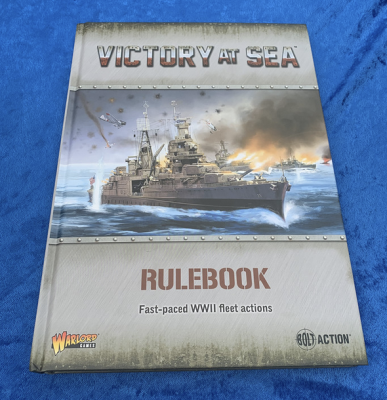 By Troy Hill
By Troy Hill
Many years ago, when I was a wee university gamer lad, I witnessed a spectacle I’d never seen before. The student union’s grand ballroom taken over by fleets of model ships, model planes on stands, torpedos, and gents with reams and notebooks full of charts and graphs, and even several pocket protectors full of colored pencils.
They were playing Fletcher Pratt’s Naval Wargame in large scale in a game that took almost two and a half days. It was a daunting first exposure to naval wargaming. One that kept me out of that genre of the hobby until John Stallard and his crew at released .
Warlord’s newest addition to their WWII line up premiered in the midst of the world’s lock-down during the pandemic. Our own local gaming scene was mostly socially distanced games in people’s garages or basements, so I didn’t worry about investing the time nor fund in the game. Until now.
Now I’m interested in , and just received my hardcover rulebook.
Before I decided whether to invest in yet another game (Warlord keeps putting out good ones, and my mountain of minis keeps growing) I wanted to read the rules, see the various fleets.
I’m more interested in the Mediterranean campaign, as well as naval engagements in the north Atlantic and around Europe than the iconic Pacific theater the starter set includes. I figure that with the U boat wolf packs, the battle for Malta, and other engagements, there should be plenty of action to game, and many ships to collect and paint on that front.
But, what of the game? I’ve played and loved Warlord’s other two naval war games, Cruel Seas, and Black Seas. How does this stack up?
 What is Victory at Sea?
What is Victory at Sea?
Warlord’s version of the game is actually a version 2 of the original game designed by Matthew Sprange. On the Official Warlord Podcast, over on the Cast Dice network, Brad and Sprange made two episodes covering in the game. , Sprange explains that when Warlord took over the game, he re-wrote the rules originally published by his own Mongoose gaming company, into a second edition version. with Brad and Spange details the full rule book that I’m about to review.
In a nutshell, VAS is a fast paced naval wargame that pits ships to fleets against each other, set in the WWII era. Although the game is designed around 1:1800 models, it can be scale agnostic. It combines Air, Surface Vessels, and Submersible vessels into one rules set. Sprange explains that the rules for submarine combat have their own section in the large rulebook.
Of course, inclusion of subs means that MTBs, or Motor Torpedo Boats are included. The rules for these small craft utilize them in squadrons, not in individual ships, like Warlord’s Cruel Seas game.
Aircraft and carriers also came into their own in WWII and are a central part of the rules. As are planes.
Initiative
The inevitable comparison will be between VAS, Black Seas, and Cruel Seas. Each game has their own character and flavor. Building off John Stallard’s popular Cruel Seas, Gabrio, the designer of Black Seas, changed the initiative system from random die draw for boat activation, to an initiative system based on where the ship was in relation to the wind direction. This made sense because the wind was a determining factor in movement.
Strange built Victory at Sea, however, with a modified U-Go-I-Go system. At the beginning of each turn, in the appropriately named Initiative Phase, players roll off, high number wins intiative for the entire turn.
The Dice
While the game uses both d10s and d6s, the d10s are used sparingly. D6s dominate the combat sequence. D10s are used more for increased range of effects that don’t get the middle weighing of a 2d6 system. Players who groaned about the use of d10s in the Cruel Seas and Black Seas games will find this game’s dice system more to their preference.
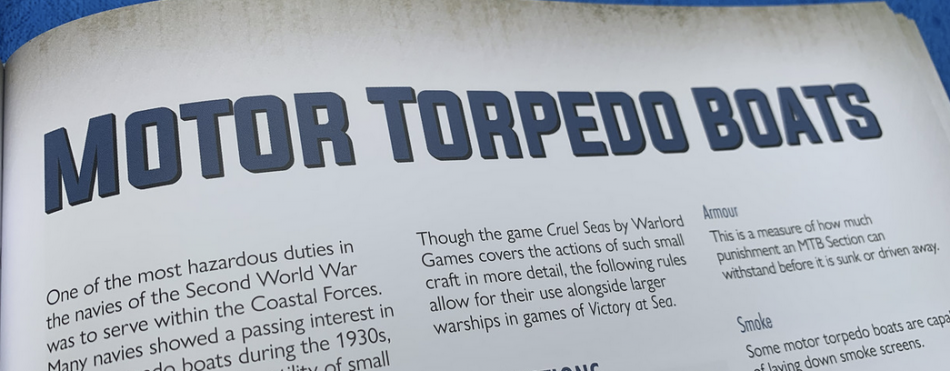 The Movement Phase
The Movement Phase
Here’s where initiative comes in to play. The player who lost the roll for initiative must chose one of their vessels to move first. Movement then alternates between players until all ships have moved.
Ships may move up to their movement rating, (most ships between 5 to 7 inches). Turns may be up to 45 degrees, but only after two inches or more of movement. Ships may turn as often as they like, but each turn must be preceded by at least a two inch move since the last turn, or start of movement.
If MTBs are in the fleets, they are moved en mass AFTER all other ships have moved. The player with initiative chooses which player shall move their MTBs first.
Aircraft movement then occurs in a similar initiative procedure as the MTBs.
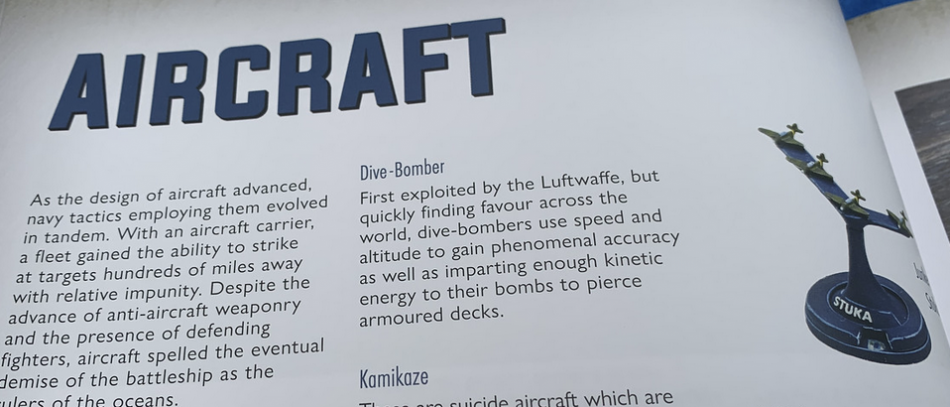 The Gunnery Phase
The Gunnery Phase
The player who won the initiative for the turn, may now select a vessel and announce the targets for that ship’s guns. Players then alternate choosing ships to fire.
All weapons have firing arcs, so the intended target must be situation within that arc, and be within range for the weapon.
Over the Horizon
The game has a nice feature in that the curvature of the Earth comes into play. Any target more than 30 inches away from the firing vessel’s bridge is considered to be beyond the horizon. To target such, the firing gunner needs to be shooting at a stationary target (land or anchored ship) and have an observation flight to guide the gunners. Number of attack dice are halved for each gun attempting such an attack, and each die need a natural 6 to score a hit.
 Captain’s Orders and Traits
Captain’s Orders and Traits
There are a variety of orders captains can issue, usually based on a crew quality check. If successful, orders such as All Hands on Deck, Evade, Come About, and Create Smoke (among others) all seem sure to add flavor to the game. Ships and weapons both have traits, some positive, some negative. Armoured Deck, Lumbering and Radar affect ships. Weapon traits include such as One Shot, Fast track, and Devastating.
The Ships
Victory at Sea uses the location of the ship’s bridge as it’s reference point for darn near everything. What can you see? Check the sight light from the bride. Pivot point for the ship’s maneuvers? The bridge. Range to a target? Bridge.
Strange mentioned on the second Warlord podcast that he had help from his Official Navy Boffins (ONB) and others in both play-testing and creating a database of ship’s statistics that could be translated into the game.
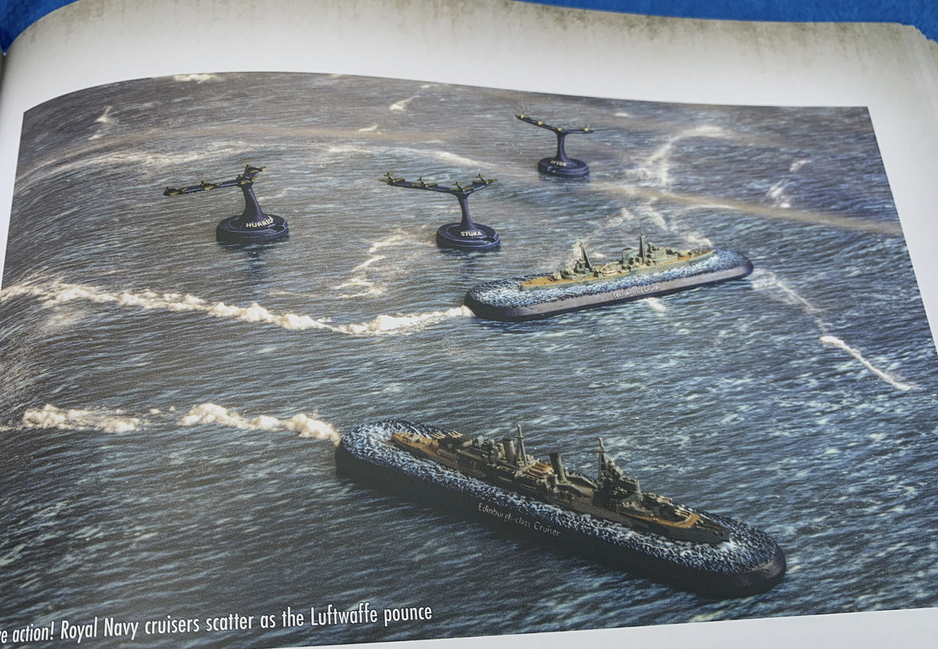
Ship classes are detailed out with movement, armament, armor, and hull points.
Like both Black Seas and Cruel Seas, VAS uses both a Hull point, and a crippled level. For example, a Fargo-Class Cruiser has a hull rating of 29/9. If such a ship takes 29 points of unrepaired damage, it sinks. However, if it takes 20 to 28 points of unrepaired damage, she is crippled. Speed is reduced, guns are damaged or inoperable.
The Book
The Warlord team has done a commendable job with this book. It includes advance rules beyond the basic set supplied in the starter box. In addition, it includes over 20 scenarios, with additional scenarios for submarine missions. Scenarios include both Pacific, Atlantic, and Mediterranean missions.
Stats are included for darn near all major types of ships for American, Britain and Commonwealth, Italy, France, Germany and Japan, as well as civilian shipping.
I have to admit, that with Covid lock-downs, I have yet to play the game, or even order ships. My local gaming crew already has several fleets from other games systems in other scales, so we hope to get some games in with those models soon.
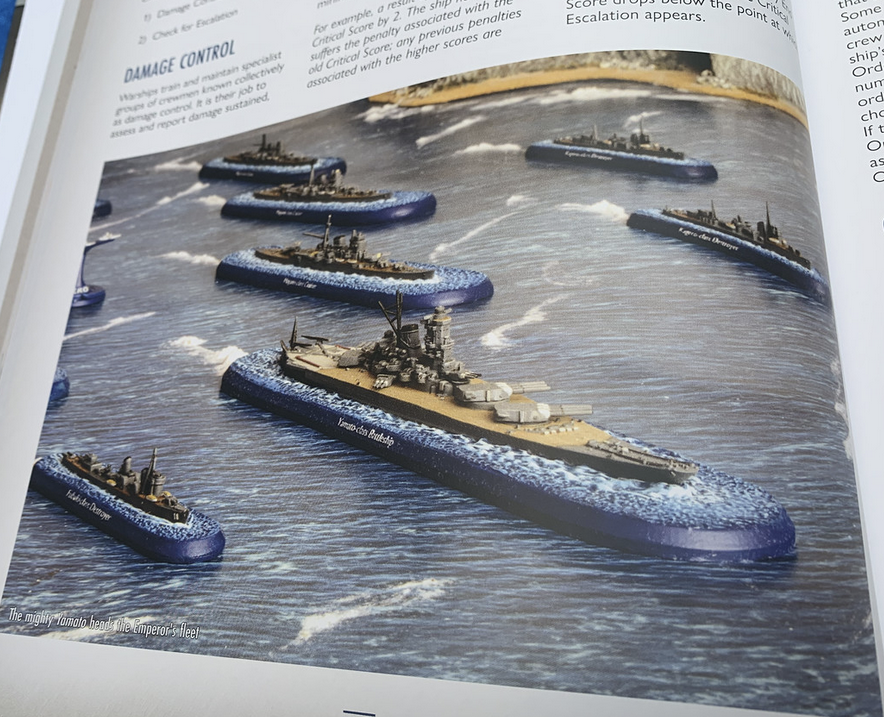 Overall Rating
Overall Rating
What Warlord does best is create games (or in this case, upgrade a game) that serves as both an entry point into a genre, and a mid-level strategic game. Victory at Sea is in that sweet spot. The rules are simple enough to give a read, paint some models, and dive right in. Yet they have additional rules (orders, traits, aircraft, submersibles, land emplacements) that the game can have even more strategic depth.
I’ve already decided on the Mediterranean as my demo-kit. Now I just have to decide what my budget will allow me to purchase this go from the Royal Navy and the Regia Marina (and eventually the Kriegsmarine) as I slowly work my way up to the battle for Malta.
The game itself fills the need that many of my Los Angeles area gaming friends said they hoped Cruel Seas would fill. The larger fleet level naval battles, without being bogged down in chart after chart after chart.

Being in the Northern LA area our gaming group has started playing VaS. Played the 1939 River Plate scenario straight from the rule book, then continued the scenario with the damaged Graf Spee breaking out for open sea vs. the HMS Cumberland and the survivors of the 1st engagement (damaged Ajax and Achilles). Tough battle… in the end the Graf Spee “listing badly” from the open sea patio battlefield as Cumberland went to Davy Jones.
Great game and rules fast pace for the novice group. Recomend, especially for ease of play for new naval gamers. We preferred to use our 1/700 naval collections with treble gunnery ranges, movement etc. instead of the 1/1800 Warlord miniatures. Warlord’s ship miniatures fine for the standard 6×4 table setup. Our game worked with no problems out on the open blue/grey titles 15’x12′ patio. WR
Do the bases come off? They ships all look like blue-hulled submarines or hovercraft otherwise. The look is off-putting to me.
I believe they are all molded as one piece. But, since many of us with Black seas fleets are basing our ships with textured bases, I’m not worried about it. Your mileage may vary. The good news is that the game rules are scale agnostic. Other manufactures make ships in smaller scales (Warlord’s are 1:1800) – and the rules still work because everything you measure is based off where the bridge is. Movement, ranges, turns, etc. So, you can purchase whichever line of ships works for you. The planes are molded four to a stand, and you measure ranges from the nose of the lead plane. I’ve considered just using a Blood Red Skies plane to represent a full flight as needed.
Thanks, Troy. A smaller scale sans stand might address a couple of my preferences for using the rules.
Troy Nice article and thanks for taking me down memory lane on playing WWII Naval miniatures with Fletcher Pratt, we used open Tennis or Basketball courts at a nearby park. I will need to get a set of these and try them out, we have playing GQ.
Great article Troy. I am inspired and have bought the hard back rule book. Now to fleet printing!